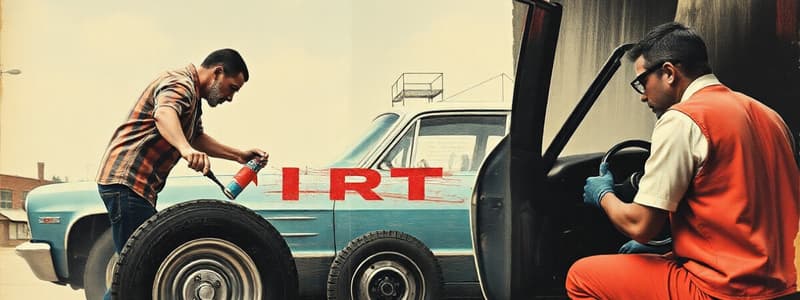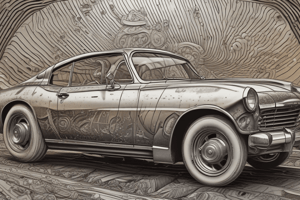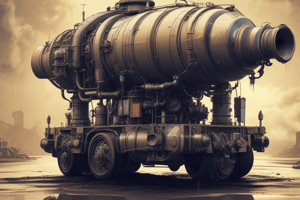Podcast
Questions and Answers
What is the recommended distance to hold the spray gun from the surface while painting?
What is the recommended distance to hold the spray gun from the surface while painting?
- About 30 cm (12 in.)
- The distance is not specified in the text.
- About 10 cm (4 in.)
- About 20 cm (8 in.) (correct)
What is the purpose of overlapping passes when spraying paint?
What is the purpose of overlapping passes when spraying paint?
- To create a textured finish.
- To prevent paint drips from forming.
- To create a thicker layer of paint.
- To ensure uniform coverage by blending the paint evenly. (correct)
Why is it important to test the spray gun before painting?
Why is it important to test the spray gun before painting?
- To check the air pressure and spray pattern settings. (correct)
- To make sure the spray gun is properly calibrated before use.
- To determine the correct drying time for the paint.
- To ensure the paint is properly mixed.
If the spray gun is not adjusted correctly, which of these issues might occur?
If the spray gun is not adjusted correctly, which of these issues might occur?
What is the main requirement for preventing corrosion?
What is the main requirement for preventing corrosion?
What is the correct way to move the spray gun when painting a flat surface?
What is the correct way to move the spray gun when painting a flat surface?
What is the purpose of painting the edges or corners first?
What is the purpose of painting the edges or corners first?
Which of the following best describes the type of spray pattern that a correctly adjusted spray gun should produce?
Which of the following best describes the type of spray pattern that a correctly adjusted spray gun should produce?
What is indicated by the depth of the groove in a tyre tread?
What is indicated by the depth of the groove in a tyre tread?
What condition can occur due to the movement of the tyre around the rim during heavy braking?
What condition can occur due to the movement of the tyre around the rim during heavy braking?
Which of the following is a significant indicator of brake wear?
Which of the following is a significant indicator of brake wear?
Which defect is NOT mentioned as affecting tyre conditions?
Which defect is NOT mentioned as affecting tyre conditions?
What can cause defects in aircraft wheels?
What can cause defects in aircraft wheels?
What occurs to brake rotors if they become excessively hot?
What occurs to brake rotors if they become excessively hot?
What is the primary reason for checking brake units between flights?
What is the primary reason for checking brake units between flights?
What indicates that the brake pads need immediate replacement?
What indicates that the brake pads need immediate replacement?
What is the primary issue indicated by rust on bolt heads and nuts?
What is the primary issue indicated by rust on bolt heads and nuts?
Which method is least effective for removing corrosion from lightly stressed areas?
Which method is least effective for removing corrosion from lightly stressed areas?
When removing corrosion from high-stressed steel components, what is a critical consideration?
When removing corrosion from high-stressed steel components, what is a critical consideration?
What should be done with cadmium-contaminated waste materials?
What should be done with cadmium-contaminated waste materials?
Why is it important to prevent scratching during corrosion removal on highly stressed parts?
Why is it important to prevent scratching during corrosion removal on highly stressed parts?
Which abrasive method is considered the most effective for removing corrosion products?
Which abrasive method is considered the most effective for removing corrosion products?
What should be the first step before applying any corrosion removal technique?
What should be the first step before applying any corrosion removal technique?
What characteristic of the finish should be restored after corrosion removal?
What characteristic of the finish should be restored after corrosion removal?
What is the significance of inspecting nicks on the leading edge of propeller blades?
What is the significance of inspecting nicks on the leading edge of propeller blades?
Which of the following is NOT considered a life-expired item on an aircraft?
Which of the following is NOT considered a life-expired item on an aircraft?
Where is corrosion most likely to occur on an aircraft?
Where is corrosion most likely to occur on an aircraft?
Which condition may indicate a problem during a ground run of an aircraft’s engine?
Which condition may indicate a problem during a ground run of an aircraft’s engine?
What maintenance action is required for aircraft light bulbs with important functions?
What maintenance action is required for aircraft light bulbs with important functions?
What component is often monitored and replaced during major servicing due to finite fatigue lives?
What component is often monitored and replaced during major servicing due to finite fatigue lives?
In terms of propeller maintenance, what is the impact of governor leaks on operation?
In terms of propeller maintenance, what is the impact of governor leaks on operation?
Which factor should NOT be included in the assessment of propeller blade conditions?
Which factor should NOT be included in the assessment of propeller blade conditions?
What type of damage could a panel or door sustain due to excessive use?
What type of damage could a panel or door sustain due to excessive use?
What should you do if you find corrosion along the seams of a door or panel?
What should you do if you find corrosion along the seams of a door or panel?
What is the purpose of a frangible device on a protective cover?
What is the purpose of a frangible device on a protective cover?
How can you identify if a fire extinguisher switch has been operated?
How can you identify if a fire extinguisher switch has been operated?
What kind of stress is a pressurised structure subjected to?
What kind of stress is a pressurised structure subjected to?
What kind of defects may be indicated by subtle changes in the skin surface of a pressurised structure?
What kind of defects may be indicated by subtle changes in the skin surface of a pressurised structure?
What should you check around the area where a sheet metal repair has been performed?
What should you check around the area where a sheet metal repair has been performed?
What is the main purpose of inspecting a pressurised structure?
What is the main purpose of inspecting a pressurised structure?
Which of the following is NOT a reason why spilled mercury on aluminium should be cleaned immediately?
Which of the following is NOT a reason why spilled mercury on aluminium should be cleaned immediately?
What is the primary reason why alkali spillage is common in NiCad and Ni-Fe batteries?
What is the primary reason why alkali spillage is common in NiCad and Ni-Fe batteries?
What is the effect of mercury amalgamation on aluminium alloys under tension stress?
What is the effect of mercury amalgamation on aluminium alloys under tension stress?
What is the most devastating effect of mercury spillage on aluminium alloys?
What is the most devastating effect of mercury spillage on aluminium alloys?
Which of the following materials is NOT susceptible to corrosion damage from mercury spillage?
Which of the following materials is NOT susceptible to corrosion damage from mercury spillage?
What is the purpose of painting compartments of batteries with anti-corrosive paint?
What is the purpose of painting compartments of batteries with anti-corrosive paint?
X-ray inspection is useful for locating spilled mercury because:
X-ray inspection is useful for locating spilled mercury because:
Flashcards
Tyre serviceability
Tyre serviceability
Indicated by the depth of grooves in the tyre tread.
Creep
Creep
Movement of the tyre around the rim due to heavy braking.
Retreading tyres
Retreading tyres
Re-treading can occur if the tyre is not badly damaged.
Brake wear
Brake wear
Signup and view all the flashcards
Brake overheating
Brake overheating
Signup and view all the flashcards
Inspection frequency
Inspection frequency
Signup and view all the flashcards
Indicators of worn brakes
Indicators of worn brakes
Signup and view all the flashcards
Wheel defects
Wheel defects
Signup and view all the flashcards
Panels and Doors
Panels and Doors
Signup and view all the flashcards
Corrosion Inspection
Corrosion Inspection
Signup and view all the flashcards
Quick-release Fasteners
Quick-release Fasteners
Signup and view all the flashcards
Emergency System Indication
Emergency System Indication
Signup and view all the flashcards
Pressurized Structure
Pressurized Structure
Signup and view all the flashcards
Fatigue Cracks
Fatigue Cracks
Signup and view all the flashcards
Blow-out Panels
Blow-out Panels
Signup and view all the flashcards
Sheet Metal Repairs
Sheet Metal Repairs
Signup and view all the flashcards
Propeller Inspection
Propeller Inspection
Signup and view all the flashcards
Leading Edge Nicks
Leading Edge Nicks
Signup and view all the flashcards
Ground Run Checks
Ground Run Checks
Signup and view all the flashcards
Lifed Items
Lifed Items
Signup and view all the flashcards
Corrosion Prone Areas
Corrosion Prone Areas
Signup and view all the flashcards
Corrosion in Magnesium & Aluminum
Corrosion in Magnesium & Aluminum
Signup and view all the flashcards
Importance of Bulb Checks
Importance of Bulb Checks
Signup and view all the flashcards
Exhaust Area Corrosion
Exhaust Area Corrosion
Signup and view all the flashcards
Alkali Spillage
Alkali Spillage
Signup and view all the flashcards
Corrective actions for alkali spillage
Corrective actions for alkali spillage
Signup and view all the flashcards
Mercury corrosion on aluminium
Mercury corrosion on aluminium
Signup and view all the flashcards
Amalgam formation
Amalgam formation
Signup and view all the flashcards
X-ray inspection for mercury
X-ray inspection for mercury
Signup and view all the flashcards
Effects of mercury spillage
Effects of mercury spillage
Signup and view all the flashcards
Immediate recovery actions for mercury
Immediate recovery actions for mercury
Signup and view all the flashcards
Protection against mercury penetration
Protection against mercury penetration
Signup and view all the flashcards
Rust on hardware
Rust on hardware
Signup and view all the flashcards
Mechanical removal
Mechanical removal
Signup and view all the flashcards
Methods to remove rust
Methods to remove rust
Signup and view all the flashcards
High-stressed components
High-stressed components
Signup and view all the flashcards
Proper finishing
Proper finishing
Signup and view all the flashcards
Cadmium compounds
Cadmium compounds
Signup and view all the flashcards
Industrial waste disposal
Industrial waste disposal
Signup and view all the flashcards
Corrosion damage evaluation
Corrosion damage evaluation
Signup and view all the flashcards
Spray Gun Adjustment
Spray Gun Adjustment
Signup and view all the flashcards
Uniform Fan-Shaped Spray
Uniform Fan-Shaped Spray
Signup and view all the flashcards
Spraying Technique
Spraying Technique
Signup and view all the flashcards
Distance from Surface
Distance from Surface
Signup and view all the flashcards
Overlapping Passes
Overlapping Passes
Signup and view all the flashcards
Corrosion Requirements
Corrosion Requirements
Signup and view all the flashcards
Eliminating Corrosion
Eliminating Corrosion
Signup and view all the flashcards
Spray Pattern Adjustment
Spray Pattern Adjustment
Signup and view all the flashcards
Study Notes
Module 7: Maintenance Practices - Structural
- This module covers structural maintenance practices for Category B2 licence holders.
- It is part of the CASA B2-07d syllabus.
- The document is controlled.
Knowledge Levels
- Level 1: Applicant familiarity with basic subject elements and simple descriptions.
- Applicant should also know typical terms.
- Level 2: General knowledge of theoretical and practical aspects with an ability to apply the
knowledge.
- Applicant understands theoretical fundamentals and gives general descriptions using examples.
- Applicant uses mathematical formulas and understands sketches, drawings and schematics related to the subject.
- Applicant is able to apply knowledge in practical situations using detailed procedures.
- Level 3: Detailed knowledge of theoretical and practical aspects and logical application.
- Applicant understands the theory and interrelationships of the subject with other subjects.
- Applicant provides detailed descriptions using both theoretical fundamentals and examples.
- Applicant understands math formulas and uses sketches, drawings, and detailed schematics.
- Applicant applies knowledge in practical situations using manufacturer's instructions.
- Applicant interprets results and can apply corrective actions based on measurements.
Table of Contents
- Aircraft Defects, Corrosion Inspection, Assessment Techniques and Reprotection (7.18.1):
- Learning Objectives
- Aircraft Defects (General Defects, External Damage, Inlets and Exhausts, Liquid Systems, Gaseous Systems, Visual Inspection Techniques, Dimensions and more)
- Corrosion Identification, Assessment and Handling (Locations of Corrosion in Aircraft, Exhaust Areas, Engine Intakes and Cooling Air Vents, Landing Gear, Bilge and Water Entrapment Area, and more)
- Corrosion Removal
- Paint Removal
- Aluminium and Aluminum Alloys:
- Properties, Corrosion attack and treatment
- Alclad
- Other Inspections: Components, Fluid lines and hoses, Wiring, Bolts, Rivets, Filters, Screens, Powerplant, Propellers, and more
- Light Bulbs
- Metal Parts: Cleanliness and External Evidence of damage, Leaks and discharge, Overheating, Fluid ingress and more
- Rubber, Fabric, Glass Fibre and Plastic Parts: Cleanliness, Cracks, Deterioration, Overheating, Fluid soakage, Attachment Security and more
- Control System Components (Cables, Chains, Pulleys, Rods, Tubes): Correct Alignment, Free Movement, Evidence of Wear, Cracks, and more
- Electrical Components: Cleanliness, Ovious damage, Evidence of overheating, Corrosion and Security of attachments and more
- External Damage(Inlets and Exhausts): Damage types, common causes of airframe damage, Ground servicing contact risks(vents and holes), and more
- Liquid Systems: Quantity checks, physical checks, leak investigation, and more
- Gaseous Systems: Leak detection and the dangers of oxygen leaks
- Visual Inspection Techniques (Dimensions of parts, condition of tires, wheels, and brakes; locating and resolving specific inspections on an aircraft)
- Disassembly, Inspection, Repair and Assembly Techniques (7.18.4): Summarize disassembly
and reassembly techniques performed during aircraft maintenance
- Complete Airframes
- Replacement of Major Components/Modules
- Replacement of Minor Components/Modules
- Basic Disassembly and Re-assembly techniques
- Use of correct tools
- Disassembly of components, safe removal methods (Jigs)
- Troubleshooting Techniques (7.18.5): Summarize troubleshooting techniques and process
- Non-Destructive Testing (7.18.3): Describe the techniques of penetrant, radiographic, eddy current, ultrasonic and borescope methods.
- Corrosion Prevention and Removal: Best methods, basic concepts and procedures
- Corrosion Protection (Aluminium Anti-Corrosive Surface Treatments): Cladding, Surface Conversion Coatings, Ferrous Metal Anti-Corrosive Surface Treatments (Nickel and Chrome Plating, Cadmium Plating, Galvanising, and Metal Spraying), and more.
- Surface Finishing Requirements, Paint (Primer), Wash Primer, or Epoxy
- Spray Gun Operation; Applying the Finish
- Corrosion Removal Techniques
- Paint Removal Techniques
- General treatment methods, and care steps
- Assessment for Serviceability, (methods for checking serviceability of various components)
Studying That Suits You
Use AI to generate personalized quizzes and flashcards to suit your learning preferences.




